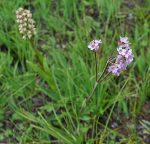 Also called nard, nardin and muskroot, this aromatic herbaceous perennial is native to the montane and subalpine zones of the Himalayas where it grows on steep, grassy slopes. Growing 4-20″ the plants have a taproot with 30-50 brown tapered rhizomes that are covered with the petioles old withered leaves and appear hairy. A lightly hairy stem has 6-8 basal leaves that are slightly hairy and 6-8″ long, and cauline leaves that are opposite, oblong to subovate, and up to 3/4″ long. In early to mid summer, depending on elevation, 3-7 condensed cymes appear bearing 40-50 bell-shaped, pinkish red to bluish white flowers. The fruit that ripens in the fall is covered with short hairs. Spikanard is valued for the highly aromatic amber-colored oil that is distilled from the rhizome. The oil was very expensive and often mixed with other cheaper oils. It was is used as a perfume, incense, sedative, and folk medicine. Spikenard is a member of the valerian family, Caprifoliaceae, that also includes honeysuckle, Abelia, and Weigelia. The genus name, Nardostachys, comes from Latin nardus, Greek νάρδος, possibly referring to the ancient Assyrian city Naarda, and the Latin word spica, meaning spike, referring to the inflorescence of the plant. The specific epithet, jatamansi, is a Sanskrit word and refers to the hairy appearance of the rhizome.
Also called nard, nardin and muskroot, this aromatic herbaceous perennial is native to the montane and subalpine zones of the Himalayas where it grows on steep, grassy slopes. Growing 4-20″ the plants have a taproot with 30-50 brown tapered rhizomes that are covered with the petioles old withered leaves and appear hairy. A lightly hairy stem has 6-8 basal leaves that are slightly hairy and 6-8″ long, and cauline leaves that are opposite, oblong to subovate, and up to 3/4″ long. In early to mid summer, depending on elevation, 3-7 condensed cymes appear bearing 40-50 bell-shaped, pinkish red to bluish white flowers. The fruit that ripens in the fall is covered with short hairs. Spikanard is valued for the highly aromatic amber-colored oil that is distilled from the rhizome. The oil was very expensive and often mixed with other cheaper oils. It was is used as a perfume, incense, sedative, and folk medicine. Spikenard is a member of the valerian family, Caprifoliaceae, that also includes honeysuckle, Abelia, and Weigelia. The genus name, Nardostachys, comes from Latin nardus, Greek νάρδος, possibly referring to the ancient Assyrian city Naarda, and the Latin word spica, meaning spike, referring to the inflorescence of the plant. The specific epithet, jatamansi, is a Sanskrit word and refers to the hairy appearance of the rhizome.
Type: Herbaceous perennial
Bloom: Three to seven condensed cymes bearing 40-50 bell-shaped, pinkish red to bluish white flowers in early to mid summer depending on the elevation
Size: 4-20″ H
Light: Full sun
Soil: Organically rich, medium moist, well-drained
Hardiness: Zones 5-8
Care: Low maintenance
Pests and Diseases: None of significance
Propagation: Seed
Photo Credit: Ed Shaw